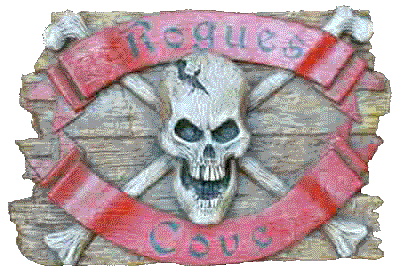A shanty is a work song that was sung by sailors as they did their jobs aboard a ship. Before the invention of engines, sailors hauled up anchors, hoisted sails, and loaded cargo by hand. Performing these jobs required great strength, and many men had to work together. The shanty supplied the rhythm for these jobs so that all the sailors knew when it was time to pull or push together. It also provided entertainment. Being work songs, shanties (with the exception of Ceremonial shanties and forecastle songs) were only sung when working, and never in a pub ashore. Lyrics for some more well known Shanties can be found on the Lyrics Page.
Also entertaining are the bawdy songs. At most Ren Faires you will definitely hear them. Some of them are period and some of them are not. Either way they are entertaining, though probably not appropriate for younger ears as may of them are suggestive, or some what lewd. They can still be a lot of fun to sing or to listen to. You can find some of these tunes on the Bawdy Songs page.
Information on Shanties
The shanty was usually sung in call-and-response style. A lead singer, known as the "shantyman," improvised or made up the solo part as he went along. Sometimes his lyrics were humorous. The sailors joined in on the chorus, which always had the same words. The shantyman, with a loud booming voice and a good imagination for making up words, was needed by the captain of a ship. Such a singer could keep all of the men working together, and everyone could hear him. The singing continued through most of the work, so a shantyman who was talented at making up verse after verse helped keep the men amused as they worked.
Most songs involved a lead singer and a choral response. The words were called out by a chantyman and the men joined in on the chorus. The words of the chorus usually coincided with a heave, or pull.
Shanties served both as a mental diversion and synchronized teamwork. They also provided an outlet for sailors to express their opinions in a manner which would not cause punishment.
Types of shanties :
- Capstan shanties: The capstan was a mushroom
shaped object with holes along the top. Sailors inserted bars into the
holes and marched around the capstan to raise the anchor. Capstan
shanties had steady rhythms and usually told stories because of the
length of time (which could be hours) it took to raise the anchor.
Sailors would stamp on the deck on the words. This gave rise to the
term, "stamp and go chanties."
- Halyard shanties: Halyard shanties were sung
to the raising and lowering of sails. Sails hung from wooden
cross-pieces called yards. With the canvas and wood, sails could weigh
between 1,000 and 2,500 pounds. To set sail a member of the crew would
climb the rigging to loosen the canvas. On deck the crew would take hold
of a line called the halyard (for haul + yard). The crew would rest
during the verse and haul during the chorus. Depending on the weight of
the sail, crews could pull one (for heavy jobs) to three (for lighter
jobs) times per chorus.
- Short drag shanties: Very difficult tasks
meant crews could pull less. Short drag shanties were used for such
tasks - such as trimming the sails or raising the masthead.
- Windlass and pumping shanties: the windlass
is also used to raise the anchor. Sailors would pump handles up and
down, making the barrel of the windlass rotate to bring the anchor chain
up. Pumps were fitting in ships to empty the bilge (the lowest part of
the ship) of water. Wooden ships leaked, but not so fast that the crew
could not pump the water out. There were several different types of
pumps, which accounts for the variation in the timing of pumping
shanties.
- Ceremonial shanties and forecastle songs:
Ceremonial and forecastle (the crews quarters) songs were those sung by
sailors on their time off (of which they didn't have a great deal).
These usually told stories of famous battles, romance or of their
longing for home. Ceremonial shanties were for times of celebration,
such as when the sailor paid off his debt to the ship or when they
crossed the equator.
For more information see the International Shanty and Seasong Association

